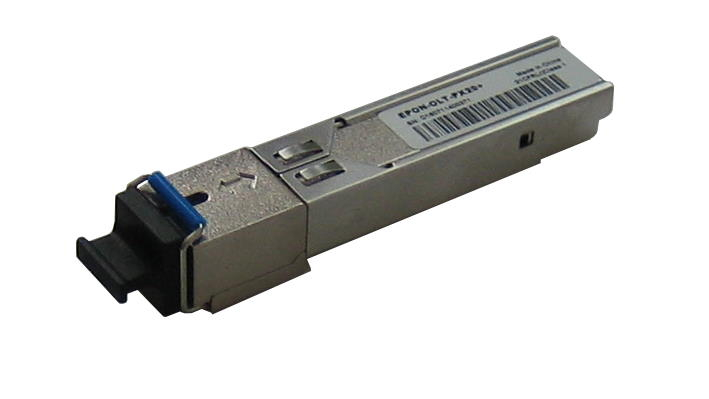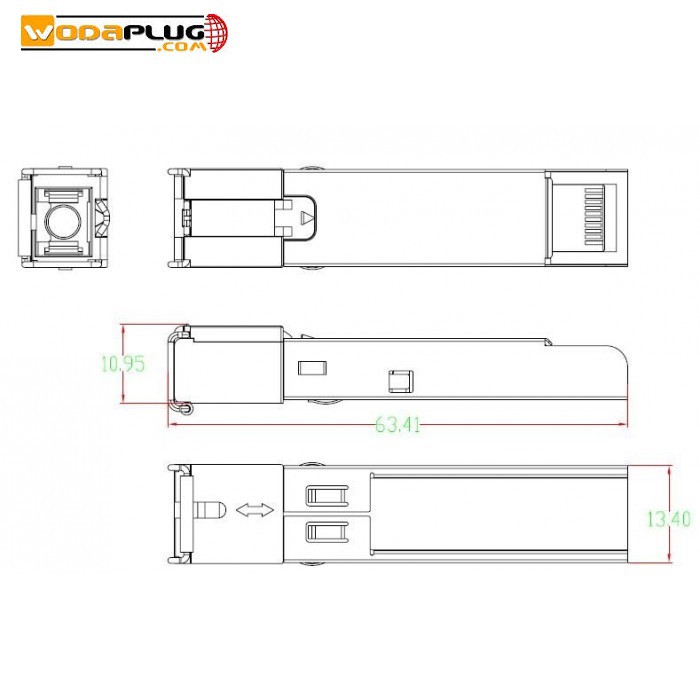Wodaplug GEPON SFP module
WDS5441H-C(H)3AL GEPON OLT SFP TRANSCEIVER MODULE, 1000BASE-PX20+++, 7dBi

General Description
WDS5441H-C(H)3AL is a high performance transceiver module for single fiber communications using a 1490nm continuous-mode transmitter and a 1310nm burst-mode receiver. It is designed to meet CTC 3.0 and IEEE802.3ah -2004 1000BASE- PX20+++ applications.
The transmitter has automatic power control (APC) function and temperature compensation circuitry to ensure stable optical power output and extinction ratio over all operating temperature range. The transmitter meets Class 1 eye safety per IEC825 and CDRH standards.
The receiver has a hermetically packaged APD-TIA (trans-impedance amplifier) pre-amplifier and a limiting amplifier with LVPECL compatible differential outputs. It features a burst-mode Loss of signal (LOS) output which is LVTTL compatible. The receiver offers bust-mode RSSI outputs, which is I2C accessible digitized data stored in the internal flash memory.
The module provides digital diagnostic information of its operating conditions and status, including transmitting power, laser bias current, module temperature, supply voltage, and burst-mode receiving power. Calibration and alarm/warning threshold data are written and stored in the internal memory (EEPROM). The memory map is compatible with SFF-8472.
Features
- Single fiber bi-directional data links application with 1.25Gbps upstream and 1.25Gbps downstream. z 1490nm continuous mode DFB transmitter.
- 1310nm burst mode APD-TIA receiver. z High power 1550nm video signal rejection . z 0 to 70°C and -40 to 85°C operating case temperature. z SFP package with SC/UPC receptacle. z Single +3.3V power supply. z LVPECL interface logic level for data input and output. z LVTTL transmitter disable control
- LVTTL transmitter laser failure alarm z LVTTL receiver Loss of Signal (LOS) indication z LVTTL RSSI Trigger control z Low EMI and excellent ESD protection z ClassⅠlaser safety standard IEC-60825 compliant z Complies with RoHS-6
Applications
- Gigabit Ethernet Passive Optical Networks(GEPON) – OLT side

Standards
- Compliant with SFF MSA – 2000
- Compliant with SFF-8472 Rev.11.0
- Compliant with IEEE 802.3ah-2004
- Compliant with FCC 47 CFR Part 15, Class B
- Compliant with FDA 21 CFR 1040.10 and 1040.11, ClassⅠ
- Complies with China Telecom EPON equipment technology requirement V3.0
Absolute Maximum Ratings
| Parameter | Symbol | Minim | Maxim | Unit | Note |
| Storage Ambient Temperature | TSTG | -40 | 85 | °C | |
| Operating Case Temperature | Tc | -10 | 75 | °C | C-Temp |
| Operating Case Temperature | Tc | -40 | 90 | °C | I-Temp |
| Operating Humidity | OH | 5 | 95 | % | |
| Power Supply Voltage | VCC | 0 | 4 | V | |
| Receiver Damaged Threshold | 4 | dBm | |||
| Soldering Temperature | 260/10 | °C/S |
Recommended Operating Conditions
| Parameter | Symbol | Minim | Typical | Maxim | Unit | Note |
| Power Supply Voltage | VCC | 3.13 | 3.3 | 3.47 | V | 3.3V±5% |
| Parameter | Symbol | Minim | Typical | Maxim | Unit | Note |
| Operating Current | Icc | 400 | mA | |||
| Operating Case Temperature | Tc | 0 | 70 | °C | C-Temp | |
| Operating Case Temperature | Tc | -40 | 85 | °C | I-Temp | |
| Operating Humidity Range | OH | 5 | 85 | % | ||
| Data Rate upstream | 1.25 | Gbit/s | ||||
| Data Rate downstream | 1.25 | Gbit/s | ||||
| Data Rate Drift | -100 | +100 | PPM |
Transmitter Optical and Electrical Characteristics
| Parameter | Symb | Minum | Typical | Maxim | Unit | Note |
| Optical Center Wavelength | λC | 1480 | 1490 | 1500 | nm | |
| Side Mode Suppression Ratio | SMSR | 30 | dB | |||
| Optical Spectrum Width | ∆λ | 1 | nm | |||
| Average Launch Optical Power | Po | +2.5 | +7 | dBm | 1 | |
| Power-OFF Transmitter Optical Power | Poff | -41 | dBm | |||
| Extinction Ratio | ER | 9 | dB | 2 | ||
| Rise/Fall Time (20%-80%) | TR/TF | 260 | ps | 2,3 | ||
| Optical Return and Loss Tolerance | 15 | dB | ||||
| Transmitter Reflectance | -10 | dB | ||||
| Transmitter and Dispersion Penalty | TDP | 2.3 | dB | 4 | ||
| Optical Waveform Diagram | Compliant With IEEE Std 802.3ah™ -2004 Figure 60-6 | |||||
| Data Input Differential Swing | Vinp-p | 200 | 2400 | mV | 5 | |
| Input Differential Impedance | Zin | 90 | 100 | 110 | Ω | |
| Transmitter Fault Indication Voltage-Low | VTx_F-L | 0.4 | V | |||
| Transmitter Fault Indication Voltage-Hight | VTx_F-H | 2.4 | V | |||
| Transmitter enable control Voltage – Low | Ven-L | 0 | 0.8 | V | ||
| Transmitter disable control Voltage – High | Vdis-H | 2.0 | VCC | V | ||
| TX Disable Negate time | Tx_on | 1 | ms | 6 | ||
| TX Disable Assert time | Tx_off | 10 | us | 6 |
Note 1: Launched into 9/125um Single Mode Fiber.
Note 2: Measured with PRBS 27-1 test pattern @1.25Gbit/s.
Note 3: Measured with the Bessel-Thompson filter OFF.
Note 4: Maximum sensitivity penalty due to transmitter and dispersion effect through 20km of SMF optical fiber.
Note 5: Compatible with LVPECL input, AC coupled internally.
Note 6: Transmitter enable and disable timing.
Receiver Optical and Electrical Characteristics
| Parameter | Symbol | Minum | Typical | Maxim | Unit | Notes |
| Operating Wavelength | λC | 1260 | 1310 | 1360 | nm | |
| Sensitivity | SEN | -30 | dBm | 1 | ||
| Saturation Optical Power | SAT | -6 | dBm | |||
| Receiver burst_mode dynamic | 15 | dB | 2 | |||
| Burst LOS Assert | LOSL-H | -45 | dBm | 3 | ||
| Burst LOS De-assert Level | LOSH-L | -31 | dBm | |||
| Burst LOS Assert time | TLOSA | 500 | ns | Figure 2 | ||
| Burst LOS Deassert time | TLOSD | 500 | ns | |||
| Receiver Reflectance | -20 | dB | @1310nm | |||
| Data Output Voltage-High | Vout_H | Vcc-1085 | Vcc-880 | mV | 4 | |
| Data Output Voltage-Low | Vout_L | Vcc-1830 | Vcc-1620 | mV | ||
| LOS Voltage – Low | LOS_L | 0 | 0.4 | V | ||
| LOS Voltage – High | LOS_H | 2.4 | VCC | V | ||
| RSSI accuracy | -3 | +3 | dB | 5 |
Note 1: Measured with a PRBS 27-1 test pattern @1.25Gbit/s and ER=10dB, BER =10-12.
Note 2: Input optical power level difference of adjacent burst packets.
Note 3: Low level indicates generic form of that burst packet is detected by the receiver.
Note 4: LVPECL output, DC coupled internally, guaranteed in the full range of input optical power (-6dBm to -30dBm).
Note 5: RSSI DDM accuracy is better than +/-2dB (25℃) or +/-3dB (0℃~70℃) for input power levels between -6 to -30 dBm. Measured with 1310nm, 1.25Gbps PRBS27-1 burst-mode optical input, ER=10dB, 50%duty cycle.